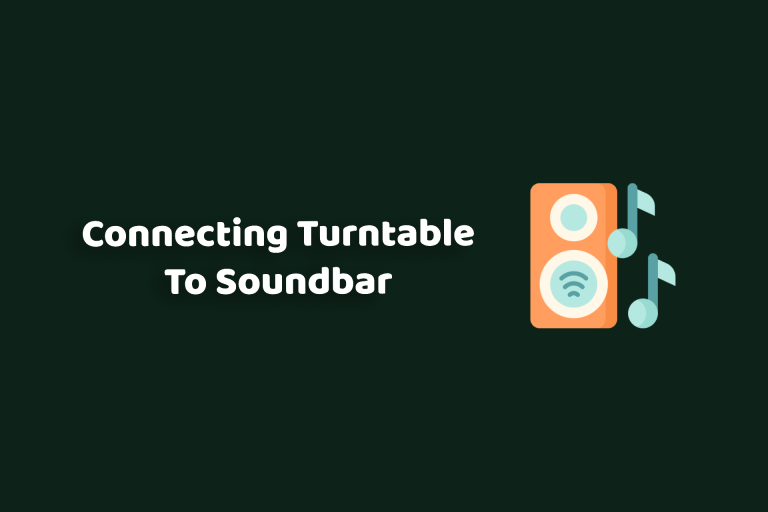How to Ground a Turntable- A Step-By-Step Guide
One of the most common reasons your turntable hums is a lack of proper grounding.
Grounding your turntable is a small yet crucial step that is often overlooked. Without it, electrical interference can interrupt your music, leading to that continuous hum.
I know how disappointing that can be. But here’s the good news: grounding your turntable is a simple fix that largely improves your vinyl sound quality.
In this guide, I will talk about why grounding is essential, how it works, and, most importantly, how you can easily ground your turntable at home. So, let’s dive in!
What is Grounding a Turntable Means?
Grounding is basically giving your turntable a way to get rid of any unwanted electric noise. When you ground a turntable, you create a path for any extra electrical current to leave the system safely instead of causing that annoying hum you hear when you play your records.
Turntables are sensitive devices, and without grounding, they can pick up all sorts of electrical disturbances. This leads to what we call a “ground loop, ” which is a term for the electrical imbalance that creates that buzzing noise.
Let’s understand this in detail:
There are usually two types of hum: 60Hz and 120Hz. Identifying the type of hum helps you understand where the problem is coming from.
- The 60Hz hum sounds like low noise and is usually caused by a bad connection—a loose wire or a faulty plug.
- The 120Hz hum is more of an aggressive buzzing sound. It is often caused by a ground loop, where the electricity gets trapped in a loop, constantly feeding back into your system.
Proper grounding helps stop this loop from happening by sending that interference away from your music.
Why is Properly Grounding Turntables Important?
If you have ever heard that hum while listening to your records (which is why you are reading this article), you know how distracting it can be. Grounding helps eliminate that noise so you can enjoy a clean and clear sound.
Grounding also helps in a few other ways, such as:
- Protects your equipment: Electrical surges can damage the delicate parts of your equipment without grounding. Grounding acts like a safety net, making sure those surges don’t cause any harm.
- Enhanced sound quality: Grounding protects the purity of the analogue signal by removing interference, which helps the turntable deliver warm, rich sound.
- Prevent ground loops: Grounding helps eliminate ground loops, a common source of unwanted noise in audio systems, ensuring smooth and uninterrupted playback.
Step-by-Step Guide to Grounding a Turntable
Let’s come to the practical part now. Grounding your turntable isn’t rocket science. I’m going to walk you through the whole process, step-b-step.
1. Safety First- Turn Off the Power
Before you start doing anything with your turntable, make sure to turn it off and unplug everything. This includes the turntable, the amplifier, and anything else connected to your system.
This is because you don’t want any live wires while you are working with electronics; even though the risk is low, you better be safe.
Once everything is powered down, you are ready for the next step.
2. Locate the Grounding Wire on Your Turntable
Next, you need to find the grounding wire on your turntable. If your turntable is new, it probably came with an attached grounding wire.
Usually, this wire is attached near the back or underneath the turntable. It is a thin wire, usually black or green, with a U-shaped connector at the end.
If you don’t see one, you can easily create your own grounding wire (I’ll explain how in a bit). But if you do have the wire, untangle it and let it hang loose for now.
3. Find the Grounding Terminal on Your Amplifier or Receiver
Now, move to your amplifier or receiver. You will find a metal post on the back panel labelled ‘’GND’’ or ‘’Ground’’. This is where you will connect the other end of your ground wire.
You can loosen it up with your fingers or a screwdriver, but don’t remove it altogether—you just need enough space to slip the U-shaped connection in.
4. Attach the Grounding Wire
Here comes the most important part: Take the U-shaped connector from your turntable’s ground wire and slide it under the screw or around the post of the grounding terminal on your amplifier.
Once it is placed, tighter the screw back down. Make sure it’s snug but not so tight that you damage the wire.
If you make the ground wire yourself, you will need an insulated wire. Strip the insulation from both ends of an insulated wire, and attach one end to the metal chassis of your turntable, and the other hand to the grounding terminal on your amp.
5. Test Your Setup
Once everything is connected, it’s time to test your setup. Plug everything back in, turn on your turntable and amplifier, and put on a record. Is that hum gone?
If so, you’ve just successfully grounded your turntable! If you still hear some noise, try tweaking the ground wire or double-checking the connections. Sometimes, it’s just a matter of tightening things up or moving the wire away from other electronics to reduce interference.
6. Extra Tips and Tricks
Here are some additional tips and tricks for grounding:
- Make sure your ground wire isn’t too long or too short. A long wire can cause more interference, while a wire that’s too short can put tension on the connections. Keep it at a comfortable length, typically around 5 feet.
- To avoid extra interference, keep your ground wire away from other wires, such as power cords or speaker cables.
- Dust and corrosion can build up on connectors over time, so check and clean your grounding points regularly.
Bonus Tip: If, despite your best efforts, you’re still getting some hum, you could try using a ground loop isolator. These devices break the ground loop in your audio chain by filtering out the electrical interference that causes the hum.
You can plug it between your turntable and your amplifier, and it should help eliminate any lingering noise.
How to Ground a Turntable Without a Grounding Wire?
As mentioned above, here’s a detailed process to make your own grounding wire with just a few tools and some basic steps.
Here’s what you need:
- Insulated wire: You can pick up any 18-22 gauge wire from a hardware store. You don’t need anything fancy—just a length that can comfortably reach from your turntable to your amplifier or receiver. About 5 feet should do it, but adjust based on your setup.
- Wire stripper or scissors: You’ll need this to remove the insulation from the ends of the wire.
- Electrical or gaffer tape: This will help secure your connections.
- Screwdriver: Just in case you need to loosen or tighten any screws.
Once you’ve got your wire, strip about half an inch of insulation from both ends. This will expose the bare metal wire inside, which is what will make the connection between your turntable and the amplifier.
If you’ve never done this before, don’t worry—it’s pretty simple. You can use a wire stripper for precision, or if you’re careful, a pair of scissors or even a small knife will do the trick.
Ground Your Turntable for a Better Sound
Now that you’ve grounded your turntable, you can finally say goodbye to that annoying hum and enjoy vinyl’s pure, rich sound.
No matter the method you use, whether the built-in ground wire or taking the DIY route, grounding ensures your setup is free from interference and ready for uninterrupted listening.
So go ahead—put on your favorite record, sit back, and enjoy the smooth, hum-free sound of your well-grounded turntable!






![Turntable Skipping Problem [FIXED]](https://turntablely.com/wp-content/uploads/2024/09/Turntable-Skipping-Problem-FIXED-1-768x512.png)